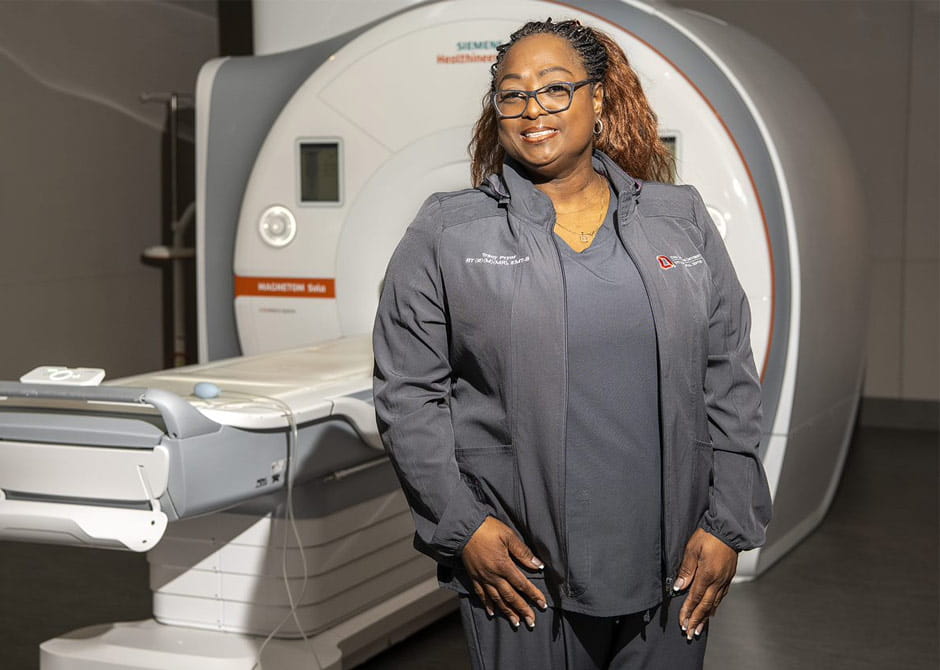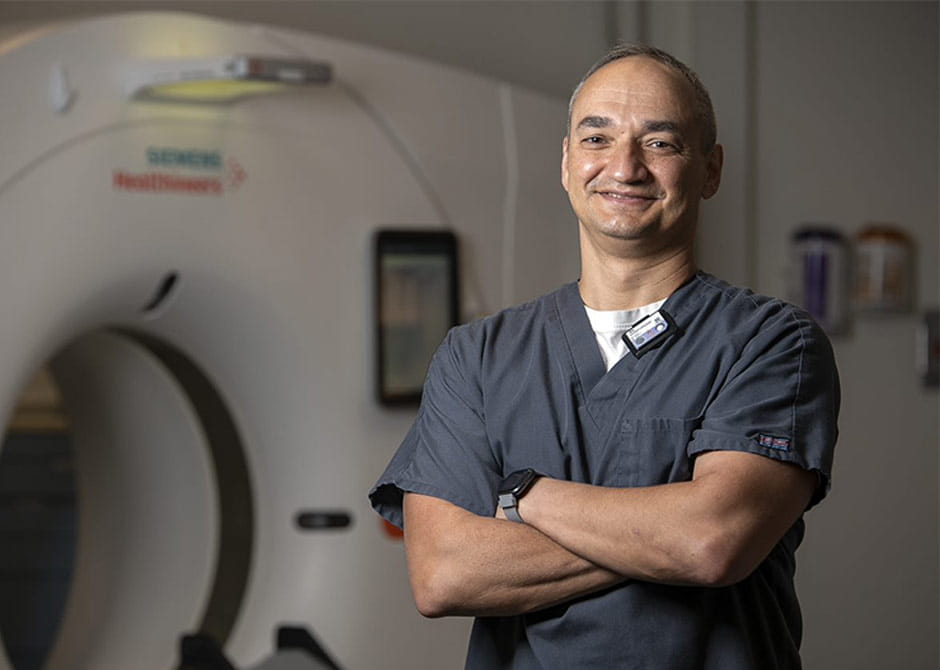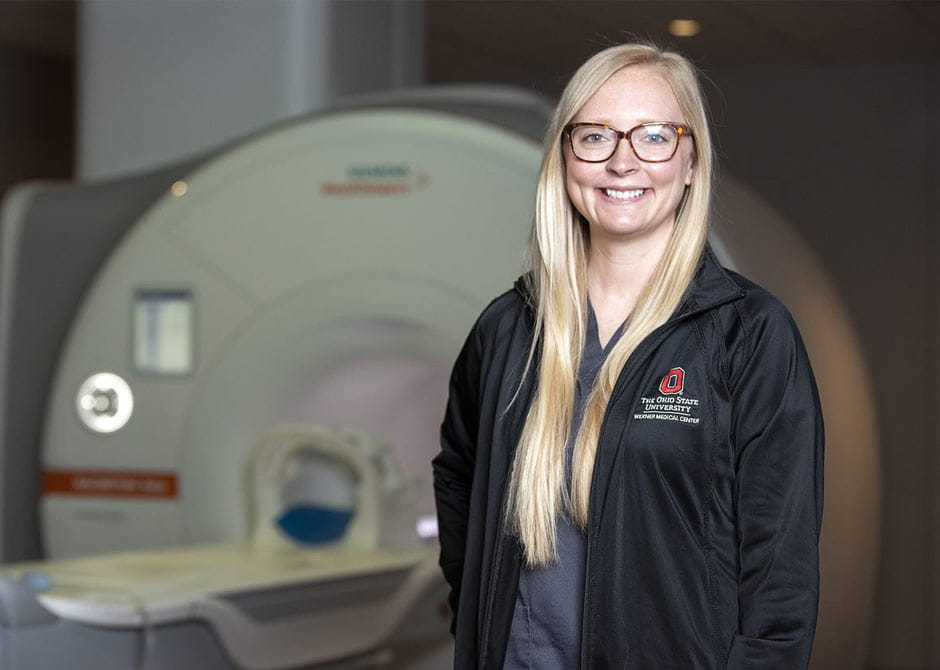As part of our medical imaging team, you’ll find a challenging and rewarding career in an academic medical center environment, with opportunities available throughout central Ohio in trauma, hospital and community settings. Whether you’re a radiologic technologist, or a mammography technologist, you can choose the setting that’s right for you and experience the camaraderie of a caring team wherever you go, with a schedule that’s flexible to meet your needs.
At our academic medical center, you’ll see a diverse patient population with complex, unique conditions. You’ll also have access to the latest evidence-based therapies and cutting-edge medical imaging technologies, working under the direction of some of the top researchers in the country with specialties including oncology, neuromuscular disease, sports medicine, trauma and cardiology.
Offering multiple bonus programs for eligible imaging titles
$15,000 Sign-on bonus
*Eligibility requirements apply.
Eligible titles include Brachytherapist, CT technologist, Dosimetrist, Echo technologist, Interventional radiology technologist, Mammography technologist, MRI technologist, Multi-modality technologist, Nuclear medicine technologist, Physicist, Radiation therapist, Radiologic technologist, Ultrasound technologist, Vascular technologist, 3D technologist, Navigation technologist, Radiologist assistant.
*Includes lead roles.
$3,000 Referral bonus
Current Ohio State employees are eligible for a referral bonus for recommending a candidate who is hired into certain positions, including medical imaging and radiology.
Interested in joining our medical imaging team?
MRI tech jobs, ultrasound tech jobs, rad tech jobs – Ohio State covers the entire spectrum of medical imaging technology. Learn more today.
It means more to be a Buckeye imaging technologist
From career advancement and professional development opportunities to working with the latest imaging technology, Ohio State offers an exciting mix of benefits and resources for Imaging Technologists at any stage of their career.
Testimonials

“Ohio State offers many avenues for you to advance your education or to become a multimodality technologist. You’ll also receive a retirement package unlike any other hospital in central Ohio.”
– Tracy, MRI Technologist

“It’s a very busy and rewarding place, we scan many traumas and see a wide range of conditions. Teamwork in our department is phenomenal! We depend on each other and help each other a lot and that makes it fun to work here.”
– Eugene, CT Technologist

“I was able to start right out of college in general radiography and with the help of the MRI program at Ohio State, within six months, I was MR registered. Ohio State creates an environment where it is easy to never stop learning, which ultimately allows me to feel fulfilled in my career.”
– Jessica, MRI Technologist
Consider a career in imaging technology at Ohio State
At Ohio State, being a part of our medical imaging team means that you’re at the very forefront of a rapidly evolving field. You’ll enjoy access to best-in-class resources, expert guidance, and opportunities for professional growth and development.
Here are some reasons to consider a career with Ohio State:
- Cutting-Edge Research and Facilities: We offer state-of-the-art research facilities and advanced medical imaging technology resources. Ohio State has specialized centers and laboratories equipped with the latest medical imaging tools, including MRI, CT, PET, and advanced microscopy. This allows our team to engage in high-level research and hands-on training with cutting-edge equipment.
- Second-to-None Expertise: Ohio State boasts a team of experts in medical imaging technology, who share a wealth of knowledge and experience, as well as provide mentorship and guidance. Our team also works with experts in engineering, medicine, and computer science as we continue to develop innovative imaging solutions.
- Professional Development: Whether you’re looking for MRI tech jobs, rad tech jobs, or ultrasound tech jobs, Ohio State offers a wide range of programs and courses that support your specific specialization. We offer educational opportunities that help you to keep pace with the latest advancements and trends, as well as providing specialized certification programs to further enhance your expertise.
- Innovation and Impact: Ohio State is committed to driving innovation and making a tangible impact in the field of imaging technology. The university supports groundbreaking research projects and encourages the development of new technologies that can improve medical diagnostics, treatment, and patient outcomes. By joining Ohio State, you become part of a community dedicated to advancing the entire frontier of medical imaging technology.
- Continuing Education: Ohio State provides comprehensive educational resources that include access to a vast library system, online databases, and technical support services. The university also offers financial aid, scholarships, and grants to help support your education and research endeavors.
What are the different kinds of medical imaging jobs?
Medical imaging is a diverse field with many different specializations and areas of patient care.
If you’re interested in starting a career in this field, here are Ohio’s requirements for some of the most in-demand imaging technologist jobs out there.
Radiologic Technologist (Radiographer)
A radiographer performs diagnostic imaging examinations, such as X-rays.
- Associate degree or bachelor’s degree in radiologic technology
- Certification from the American Registry of Radiologic Technologists (ARRT)
- Licensure from the Ohio Department of Health’s (ODH) Radiologic Licensure Program
Magnetic Resonance Imaging (MRI) Technologist
MRI techs operate scanners to create detailed images of tissues and organs.
- Associate degree in radiologic technology, followed by specialized training in MRI
- Certification from the ARRT in MRI, or from the American Registry of Magnetic Resonance Imaging Technologists (ARMRIT)
- Licensure is not required. MRI techs, however, must be certified and licensed if they perform other radiologic procedures
Computed Tomography (CT) Technologist
CT techs use scanners to produce cross-sectional images of patients’ bodies.
- Associate degree in radiologic technology, with additional training in CT imaging
- Certification from the ARRT in CT scanning
- Licensure from the ODH’s Radiologic Licensure Program
Ultrasound Technologist (Sonographer)
A sonographer captures images of internal body structures using sonography equipment. These techs often specialize in areas like obstetric, abdominal or vascular sonography.
- Associate or bachelor’s degree in diagnostic medical sonography
- Certification from the American Registry for Diagnostic Medical Sonography
Nuclear Medicine Technologist
A nuclear medicine tech prepares and administers radioactive drugs, as well as operates imaging equipment to visualize how these drugs move through the body.
- Associate or bachelor’s degree in nuclear medicine technology
- Certification from the Nuclear Medicine Technology Certification Board (NMTCB) or the ARRT in nuclear medicine
- Licensure from the ODH
Radiation Therapist
A radiation therapist treats cancer and other diseases by administering radiation treatments.
- Associate or bachelor’s degree in radiation therapy
- Certification from the ARRT in radiation therapy
- Licensure from the ODH
Mammography Technologist
A mammography tech performs mammograms, which aid in the early detection and diagnosis of breast cancer.
- Associate or bachelor’s degree in radiologic technology, with additional mammography-specific training
- ARRT certification in radiography and mammography
- Licensure from the ODH
Interventional Radiologic Technologist
An interventional radiologic tech assists in minimally invasive procedures guided by imaging, such as angiograms or placing stents.
- Associate or bachelor’s degree in radiologic technology
- Certification from the ARRT in radiography, with additional training and certification in interventional radiology (VI) if required by employer
- Licensure from the ODH
Cardiovascular Technologist
A cardiovascular tech assists in diagnostic and therapeutic procedures involving the heart and blood vessels, including echocardiograms and cardiac catheterizations.
- Associate degree in cardiovascular technology or a related field
- Certification from Cardiovascular Credentialing International or ARRT in cardiovascular interventional technology
Positron Emission Tomography (PET) Technologist
A PET tech performs PET scans to observe metabolic processes in the body.
- Associate or bachelor’s degree in nuclear medicine technology or radiologic technology
- Certification from the NMTCB or the ARRT in nuclear medicine
- Additional specialized training in PET imaging is required
- Licensure from the ODH as a radiologic technologist or nuclear medicine technologist
Diagnostic Medical Physicist
A diagnostic medical physicist maintains the safe and effective use of radiation in medical imaging, as well as the development of new imaging techniques.
- Doctoral degree (PhD) in medical physics or a related field
- Certification from the American Board of Radiology in diagnostic medical physics
- Licensure from the ODH as a medical physicist
Imaging Informatics Specialist
An imaging informatics specialist manages and supports imaging systems and data, including picture archiving and communication systems.
- Bachelor’s or master’s degree in health informatics, biomedical informatics or a related field
- Certification from the American Health Information Management Association or the American Medical Informatics Association
- Ohio requires specialized training in medical imaging informatics and information technology systems
Medical Imaging Manager/Director
A medical imaging manager or director oversees the operations of a medical imaging department, including staff management, budgeting and compliance with regulations.
- Bachelor’s or master’s degree in healthcare administration, business administration or a related field
- Certification in health care management or leadership
- Extensive medical imaging and management experience
Research Scientist in Medical Imaging
A research scientist in medical imaging conducts research to develop new imaging technologies and techniques.
- PhD in medical physics, biomedical engineering, radiological sciences or a related field
- Certification isn’t required, but is encouraged
- Extensive research experience in medical imaging
For the most up-to-date information on the Ohio Department of Health’s licensure requirements, visit their Radiologic Licensure website.
Discover more about being a Buckeye
Helpful Links
The Ohio State University is an equal opportunity employer.
All qualified applicants will receive consideration for employment without regard to age, ancestry, color, disability, ethnicity, gender identity or expression, genetic information, HIV/AIDS status, military status, national origin, race, religion, sex, gender, sexual orientation, pregnancy, protected veteran status, or any other basis under the law.


